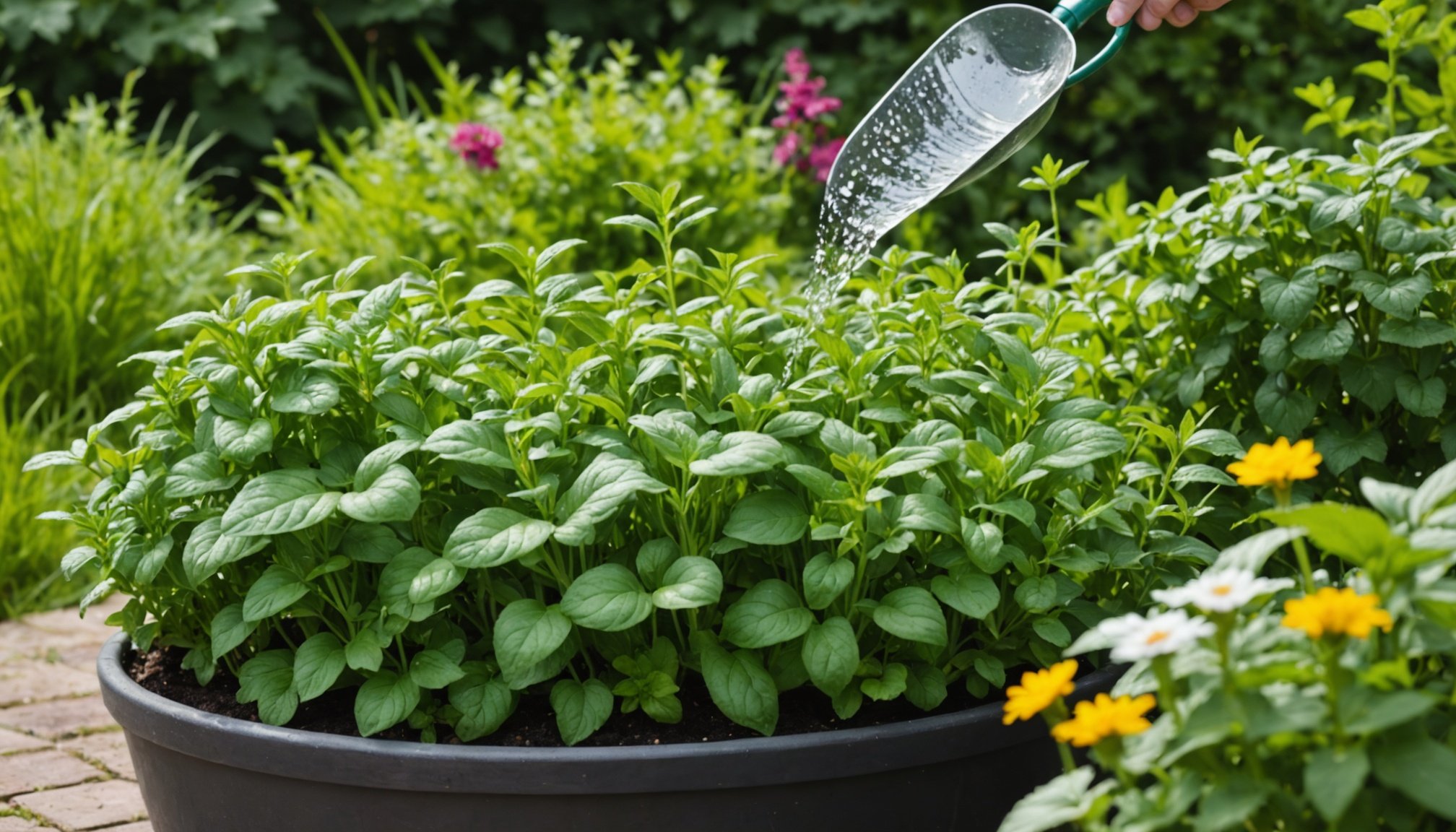Understanding the Impact of UK’s Summer Climate on Herb Gardens
In the unique context of the UK’s summer climate, adapting an herb garden to thrive necessitates an understanding of several vital factors. The UK’s weather is unpredictable, with conditions ranging from hot and dry spells to cooler, wet stretches. This variability directly affects herb growth, often causing stress if conditions are either too dry or too wet. Thus, climate adaptation is crucial for maintaining a healthy herb garden.
Herb gardeners must keep an eye on key weather patterns to make informed watering decisions. During dry spells, herbs may require increased watering to avoid wilting. Conversely, frequent rains can lead to waterlogged soil, which is detrimental to many herb species. Knowing when to adjust watering schedules is paramount for garden success.
A lire aussi : Essential Tips for Effectively Winterizing Your Northeast UK Pond
Common challenges faced by herb gardeners during the UK summer include managing water levels, pests, and potential diseases that thrive in high humidity. Certain herbs, like basil, are sensitive to these conditions and require extra care. Herb garden climate adaptation, therefore, involves not just reacting to weather changes but anticipating them and planning accordingly. Monitoring weather forecasts and understanding individual herb needs can go a long way in ensuring robust growth despite the climatic unpredictability.
Essential Watering Techniques for Herb Gardens
Providing the right amount of water is crucial for the health of your herb garden. Let’s delve into the various watering methods for herbs to ensure your plants thrive.
Lire également : Ultimate Guide to Nurturing Bonsai Trees in Northern UK Homes: Tips for Growth and Care
Drip Irrigation
Drip irrigation stands out as an excellent choice for herb gardens due to its precise delivery system. It targets water directly to the roots, minimizing wastage and reducing evaporation losses. This method not only conserves water but also fosters healthy growth by maintaining optimal moisture levels. Best practices for drip irrigation include checking for clogs and ensuring even distribution. Regular maintenance is vital to prevent leaks and ensure longevity.
Soaker Hoses
Soaker hoses are another effective tool, offering a simple installation process and low maintenance. They deliver water directly to the soil, reducing leaf wetness which can help prevent disease. Place them strategically around plants to maximize absorption. Compared to traditional watering methods, soaker hoses save time and water, making them a financially savvy option for herb enthusiasts.
Manual Watering
When manually watering, ensure you do so early in the morning or late afternoon to reduce evaporation. To determine water needs, observe signs like drooping leaves or dry soil. Avoid common mistakes such as overwatering or focusing only on plant foliage; it’s essential to soak the root zone for effective hydration.
Developing a Watering Schedule
Creating an effective watering schedule for herb gardens is essential for maintaining the health of your plants. There are several factors to consider in this process. It’s important to account for factors such as soil type, humidity levels, and the specific moisture needs of each herb species. Herbs like mint, for instance, thrive with more frequent watering, while rosemary prefers drier conditions.
Adjustments must also be made based on rain forecasts and temperature changes. If rain is expected, you might skip watering for a few days to prevent over-saturation. On hotter days, increasing the frequency of watering can help combat evaporation and keep the herbs hydrated. Seasonal changes further necessitate alterations: in the heat of summer, herbs may require more water, while in cooler months, watering might be reduced.
Examples of seasonal watering adjustments include adapting to herbs like basil or cilantro, which might require daily hydration during peak summer months. In contrast, during autumn, you might reduce to a few times weekly. Employ a moisture meter for precision, giving you confidence to modify your schedule accordingly. By understanding these dynamics, you ensure that your watering schedule effectively supports healthy and flourishing herb gardens throughout the year.
Adaptation Strategies for Different Weather Scenarios
Managing herbs through varying weather conditions necessitates adaptability and foresight. Proper weather adaptation for herb care ensures robust growth, even under challenging circumstances.
During Heatwaves
Extreme heat can quickly damage herbs, making emergency watering techniques vital. In such conditions, water herbs deeply in the early morning or evening to minimize evaporation. Employing mulch aids significantly in soil moisture retention by reducing surface runoff and keeping roots cool. Consider using shade cloth to protect delicate plants from intense sunlight, preventing leaf scorch.
After Heavy Rain
Heavy rain can lead to waterlogged conditions, suffocating herb roots. First, check soil drainage to ensure water disperses swiftly. Aerating the soil can improve drainage, while raising plant beds facilitates quicker drying and prevents stagnant water issues. Observing herb health post-rain is crucial, as symptoms of root decay may develop, requiring immediate intervention to save the plants.
Seasonal Transition
As summer wanes, adjusting watering practices readies herbs for cooler temperatures. Gradually reduce watering frequency to adapt herbs to the autumn climate, preventing shock from sudden changes. Re-assessing the herb garden setup for increased rain and cooler winds can improve adaptability, ensuring they stay healthy and productive throughout seasonal transitions. Proper planning during these times is foundational for year-round thriving herb gardens.
Common Mistakes to Avoid in Herb Garden Watering
When caring for an herb garden, understanding herb watering pitfalls is crucial to maintaining plant health. A frequent mistake is the dilemma between overwatering and underwatering. Each has significant consequences. Recognising the signs early is beneficial: wilting and yellowing leaves may indicate too much water, while dry, brittle foliage often suggests too little.
Another overlooked aspect is the impact of the watering time of day. The optimal time is early morning. This allows water to soak into the soil deeply before the sun evaporates it. Evening watering might seem convenient but can leave leaves damp overnight, increasing the risk of mildew and disease.
Misconceptions about watering frequency often lead to imbalanced hydration. Many assume herbs need daily watering. However, the right frequency varies based on the plant type, maturity, and environmental conditions. As a rule of thumb, it’s better to water deeply but less frequently, encouraging roots to grow deeper and stronger.
In summary, avoiding these common mistakes improves herb health and growth potential. By ensuring adequate and timely watering, gardeners can maintain vibrant and productive herb gardens. Remember: balance and routine matter just as much as water quantity for herb garden success.
Expert Insights and Recommendations
Cultivating a thriving herb garden requires more than just good soil and sunlight. According to horticulturists, mastering the art of watering is crucial. Overwatering can lead to root rot, while underwatering might leave your herbs parched. A horticulturist from the Royal Horticultural Society suggests, “The key is knowing your herbs’ unique needs and adjusting your watering schedule accordingly.” For instance, Mediterranean herbs like rosemary and thyme thrive in drier conditions, whereas basil prefers more moisture.
Having the right tools can significantly ease the process of herb gardening. Experts recommend investing in a self-watering planter to maintain consistent moisture levels. Additionally, a high-quality watering can with a slim spout can make the precision of watering specific areas more manageable and efficient.
For those keen on expanding their knowledge, various resources offer continuing education on herb gardening. In the UK, institutions like the RHS provide online courses and workshops tailored to enthusiasts of all levels. Engaging in these programmes can elevate your gardening skills substantially.
- Self-watering planters for consistent moisture
- Slim-spout watering cans for precision
- RHS online courses for further learning
By integrating these expert tips and resources, you can transform your herb garden into a veritable sanctuary of lush, aromatic plants.











